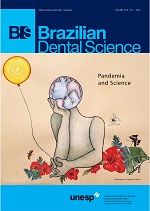Effect of chitosan nanoparticles on microtensile bond strength of resin composite to dentin: an in vitro study
DOI:
https://doi.org/10.14295/bds.2020.v23i2.1902Abstract
Objective: The purpose of this study was to evaluate the effect of chitosan nanoparticles on microtensile bond strength of resin composite to dentin using self etch adhesive after aging. Material and Methods: A total number of 90 freshly extracted, sound human molar teeth. Flat tooth surface was gained after cut of the occlusal surface. Three main groups according to pretreatment of dentin before adhesive application; 0.2 % chitosan, 2.5 % chitosan and no treatment control group. Universal self etch adhesive were applied according to manufacture instruction and 4 mm of Feltik Z250 xt composite. Storage of specimens for 1 day, 3 months and 6 months in 37O C distilled water. After that, the tooth was sectioned to beams of 1 mm x8 mm sticks for microtensile bond strength test using universal testing machine. Scanning electron microscope (SEM) was used to evalute the effect of chitosan nanoparticles on dentin and smear layer. Kruskal-Wallis test was used to compare between the three groups as well as the three aging periods. Dunn’s test was used for pair-wise comparisons. The significance level was set at P ? 0.05. Results: chitosan 0.2% is statistically significant increase in bond strength than chitosan 2.5% and control in one day group. Three months chitosan 0.2 % groups have statistically significant increase in bond strength than chitosan 2.5%. It was found in 6 months that control and chitosan 0.2 % have statistically significant increase in bond strength than chitosan 2.5%. There was statistically significant difference found between the three studied groups regarding bond strength at different storage times . Conclusion: Microtensile bond strength was influenced by different chitosan concentration. Different aging periods had no effect on the microtensile bond strength without application of chitosan and with application of 2.5% chitosan concentration.
KEYWORDS
Chitosan nanoparticles; Microtensile bond strength; MMPs.
Downloads
References
Spencer P, Jonggu Park QY, Misra A, Bohaty BS, Singh V, Parthasarathy R, et al . Durable bonds at the adhesive/dentin interface: an impossible mission or simply a moving target? Braz Dent Sci. 2012;15(1):4–18.
MATOS AB, TREVELIN LT, SILVA BTF da, FRANCISCONI-DOS-RIOS LF, SIRIANI LK, CARDOSO MV. Bonding efficiency and durability: current possibilities. Braz Oral Res. 2017;31(suppl 1):3–22.
Cheung RCF, Ng TB, Wong JH, Chan WY. Chitosan: An update on potential biomedical and pharmaceutical applications. Vol. 13, Marine Drugs. 2015. 5156–5186 p.
Del Carpio-Perochena A, Bramante CM, Duarte MA, de Moura MR, Aouada FA, Kishen A. Chelating and antibacterial properties of chitosan nanoparticles on dentin. Restor Dent Endod. 2015;40(3):195–201.
Kishen A, Shrestha S, Shrestha A, Cheng C, Goh C. Characterizing the collagen stabilizing effect of crosslinked chitosan nanoparticles against collagenase degradation. Dent Mater. 2016;32(8):968–77.
Elsaka S, Elnaghy A. Effect of addition of chitosan to self-etching primer: antibacterial activity and push-out bond strength to radicular dentin. J Biomed Res. 2012;26(4):288–94.
Lobato MF, Turssi CP, Botelho Do Amaral FL, Franca FMG, Basting RT. Chitosan incorporated in a total-etch adhesive system: Antimicrobial activity against Streptococcus mutans and Lactobacillus casei. Gen Dent. 2017;65(1):62–6.
Daood U, Iqbal K, Nitisusanta LI, Fawzy AS. Effect of chitosan/riboflavin modification on resin/dentin interface: Spectroscopic and microscopic investigations. J Biomed Mater Res - Part A. 2013;101 A(7):1846–56.
Montagner AF, Sarkis-Onofre R, Pereira-Cenci T, Cenci MS. MMP inhibitors on dentin stability: A systematic review and meta-analysis. J Dent Res. 2014;93(8):733–43.
Sivakami MS, Gomathi T, Venkatesan J, Jeong HS, Kim SK, Sudha PN. Preparation and characterization of nano chitosan for treatment wastewaters. Int J Biol Macromol. 2013;57:204–12.
Nunes RA de C, Amaral FLB do, França FMG, Turssi CP, Basting RT. Chitosan in different concentrations added to a two-step etch-and-rinse adhesive system: influence on bond strength to dentin. Brazilian Dent Sci. 2017;20(4):55.
Mittal A, Dadu S, Yendrembam B, Abraham A, Singh NS GP. Comparison of new irrigating solutions on smear layer removal and calcium ions chelation from the root canal: An in vitro study. Endodontology. 2018;30:55–61.
Balaji H. MMP inhibitors-A review Introduction. Int J Pharm Sci Heal Care Issue. 2017;7(7):45–56.
Münchow E, Bottino M. Recent Advances in Adhesive Bonding: The Role of Biomolecules, Nanocompounds, and Bonding Strategies in Enhancing Resin Bonding to Dental Substrates. Curr Oral Heal Reports. 2017;4(3):215–27.
Antonio M, Angelo R, Luis E, Debora F, Paulo C, Ricardo GS, et al. Analysis of shelf life od chitosan stored in different types of packaging, usng colorimetry and dentin microhardness. Restor Dent Endod. 2017;42(2):87–94.
Shrestha A, Friedman S, Kishen A. Photodynamically crosslinked and chitosan-incorporated dentin collagen. J Dent Res. 2011;90(11):1346–51.
Liu Y, Tjäderhane L, Breschi L, Mazzoni A, Li N, Mao J, et al. Limitations in bonding to dentin and experimental strategies to prevent bond degradation. J Dent Res. 2011;90(8):953–68.
Gajjela R, Satish R , Sajjan G, Varma K , Rambabu T VLB. Comparative evaluation of chlorhexidine, grape seed extract, riboflavin/chitosan modification on microtensile bond strength of composite resin to dentin after polymerase chain reaction thermocycling: An in vitro studyitle. J Conserv Dent. 2017;20:120–4.19 Gu L, Cai X, Guo J, Pashley D, Breschi L, Xu H, et al. Chitosan-Based Extrafibrillar Demineralization for Dentin Bonding. J Dent Res. 2019;98(2):186–93.
Cuevas-Suárez C, Da Rosa O, Lund R, Da Silva A, Piva E. Bonding performance of universal adhesives: An updated systematic review and meta- analysis. J Adhes Dent. 2019;21(1):7–26
Buzalaf M, Kato M, Hannas A. The role of matrix metalloproteinases in dental erosion. Adv Dent Res. 2012;24(2):72–6.
- Ururahy M, Curylofo-Zotti F, Galo R, Nogueira L, Ramos A, Corona S. Wettability and surface morphology of eroded dentin treated with chitosan. Arch Oral Biol. 2017;75:68–73
Downloads
Additional Files
Published
How to Cite
Issue
Section
License
Brazilian Dental Science uses the Creative Commons (CC-BY 4.0) license, thus preserving the integrity of articles in an open access environment. The journal allows the author to retain publishing rights without restrictions.
=================




























